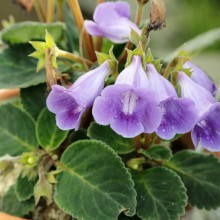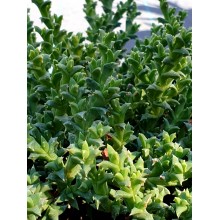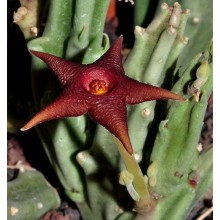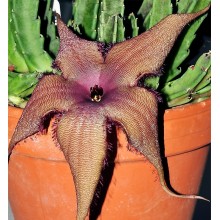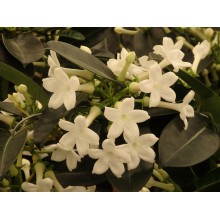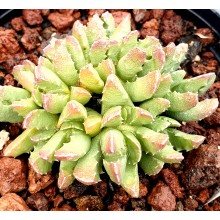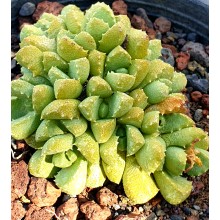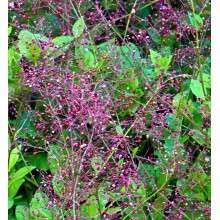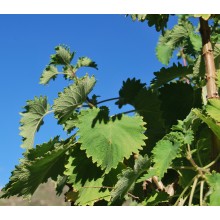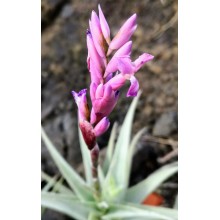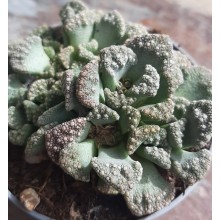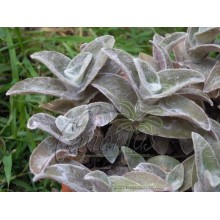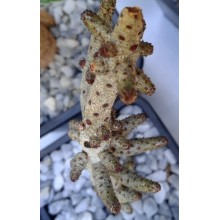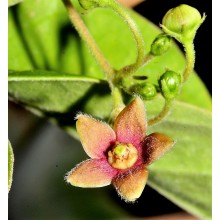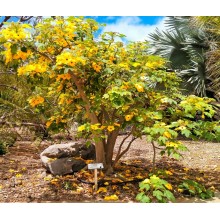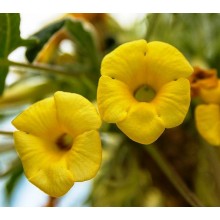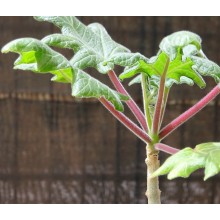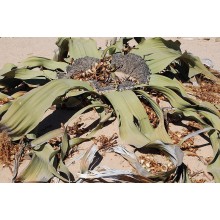Succulents There are 628 products.

World deserts and dry areas are home to the most interesting plants. Canarius offers an increasing selection of succulent plants of maximum quality, because they are grown outdoors, under the full sun of the Canary Islands.
Succulents or "fat plants" are water-retaining species, adapted to dry conditions. They store succum (juice, water) in their leaves, stems or roots, and often show a stout and fleshy appearance.
Subcategories
-
Agave
Agave is a genus of succulent plants from America. Some species grow in cold areas and take hard frost, while some others live in tropical climates. Some are tiny dwarfs and some are giants, up to 2 or 3 m wide.
Cold hardy agaves can create an exotic effect in your garden. Agave species make fine companions to palms or cacti. Variegated agaves are incredibly sought after by collectors. Our web shop offers an ever changing selection of species. We ship bare rooted plants, unless otherwise specified.
-
Aloe, Gasteria & Haworthia
Aloe, Gasteria and Haworthia are three related genera, comprising hundreds of succulent plants. They are all easily grown in pots. A few adapt to low-light levels of indoor conditions and can be grown as house plants.
- Aloe is a genus of about 400 species, native to Africa, Arabia and Madagascar. Small or dwarf aloes are becoming especially popular in colder climates as they can be taken indoors during the hardest months.
- Gasteria includes some 80 species endemic to South Africa, known for their spectacular leaves which are glossy, mottled and textured. They bloom in Spring-Summer with long spikes of small orange flowers. Some species are so variable that we offer particular clones from specific locations.
- Haworthia is a genus endemic to South Africa with about 70 species and a number of local subspecies, varieties and forms. Leaves are often banded, speckled, dotted, or semi-translucent and show wide variations.
-
Crassulaceae
This is a new, growing section of species from the family Crassulaceae. There are about 1,400 species in 33 genera and their distribution is worldwide, but mostly occur in the Northern Hemisphere and Southern Africa, especially in dry habitats. Here you can buy healthy, sun-hardened plants grown in the Canary Islands and shipped to your home.
-
Mesembs
This group of desert plants is briefly named Mesembs because they belong to a botanical family formerly named Mesembryanthemaceae. There are almost 2.000 species, mainly found in Southern Africa, with extreme adaptations to dry habitats. Some are called "living stones", as they look like pebbles. Many are easy to grow and their main need is full sun. Some are difficult because they grow in truly extreme areas.
Our Web Shop offers sun grown healthy plants, with compact and colourful leaves. Some plants are sold as cuttings, and others as rooted plants, of at least two years old.
-
Sansevieria
Recently assigned to the family Asparagaceae, the genus Sansevieria counts about 70 species, nearly all native to Africa, Arabia and Madagascar. Perennial herbs adapted to dry habitats with stiff, succulent leaves, their length ranges from a few centimeters to 2 meters. Sansevieria trifasciata and its many cultivars are among the most popular houseplants, popularly called mother in law's tongue. A well grown plant usually produces a spike of many white, richly scented flowers and then orange berries. Even the rarest species are resistant to neglect, provided you keep them from frost in winter and scorching sun in summer.
-
Hoya
Hoyas are twining vines, with showy exotic flowers, from the rainforests in Asia and Oceania. Most species grow in bright shade or morning sun, but they will also grow indoors as house plants. They are well suited for baskets, trellises or ladders. They tolerate a few weeks of drought but they are sensitive to frost and cold. Many hoyas are easy to grow and bloom, while some are tricky and rare.
-
Asclepiads
Asclepiads or Asclepiadoideae are a subfamily in the Apocynaceae, with about 2900 species. There are lots of leafless stem succulents but also perennial herbs, shrubs, lianas or rarely trees. They produce remarkable flowers, for the complex mechanisms they have developed for pollination. Many species produce an unusual fragrance, often called "carrion", and attracts flies for pollination. -
Caudiciforms
These plants from dry areas produce an unusually thick stem, the caudex. They are also called pachycauls and they have a disproportionately thick trunk, often with few branches. The caudex can be hidden underground, but in most cases they grow upwards, forming spectacular trees. The largest caudiciforms in the world are the baobabs. -
Other succulents
Here you will find all those species of desert plants that are not included in their own category. We will place here all plants from unusual families, other than Agaves, Aloes, Crassulaceae, Sansevieria, Mesembs, Epiphytic cacti, etc.
-
Sinningia speciosa 'Pedra Lisa'
Sinningia speciosa 'Pedra Lisa'
This is a nice wild form of the popular semi-succulent gesneriad named Sinningia speciosa. It has almost-white flowers with dark throat and some mauve on the tube, Leaves are also nice with the typical velvety touch and pale veins contrasting with the much darker leaf blade.
18,20 € -
Smicrostigma viride
Smicrostigma viride
Succulent shrublet of just 10-40 cm, from the Cape of South Africa. Curved green stems, made of "pairs of leaves" branch geometrically, creating an intriguing pattern.
10,30 € -
Stapelia kwebensis
Stapelia kwebensis
Stems are bright green, with the area between the ribs darker. They bear maroon flowers up to 3 cm in diameter in winter and spring. Its name refers to the Kwebe Hills in Botswana, but it is widespread in different South African countries.
24,30 € -
Stephanotis floribunda
Stephanotis floribunda
Succulent vine from Madagascar with pure white flowers of unrivalled beauty and fragrance. It grows outdoors in warm mediterranean to tropical conditions.
19,80 € -
Stomatium loganii
Stomatium loganii
This native of the Western cape has Jade coloured leaves and night-scented yellow flowers. Stomatium species come from inland So. Africa and they are hardy to frost.
10,80 € -
Stomatium mustelinum
Stomatium mustelinum
Nice-looking mesemb with gray warty leaves. It forms very cute low clumps or carpets and blooms profusely with yellow flowers that open in the late afternoon and are scented through the night.
10,40 € -
Strelitzia reginae 'Juncea' - Large
Strelitzia reginae 'Juncea' - Large
This strelizia is adapted to harsh conditions and lacks normal leaves. Leaf stalks taper to a tip with no blade, so the leaves look like fleshy spikes. The flower is much like the popular bird of paradise.
68,90 € -
Talinum paniculatum
Talinum paniculatum
Tuberous-rooted perennial native to Tropical America, with fleshy leaves and delicate pink flowers followed by the small and colourful pink-white-yellow-red fruits. It is considered an ornamental, a caudiciform. a medicinal plant. and in some countries even used as a vegetable
11,50 € -
Tetradenia riparia
Tetradenia riparia
Ornamental and aromatic shrub. 1-3 m tall, with velvety leaves and stems, It is intensely perfumed when scrubbed and bears sprays of cream-white flowers.
18,30 € -
Tillandsia purpurea
Tillandsia purpurea
This species creeps on sand fields in the harshest desert conditions, where no other plants are seen in miles. Tillandsia purpurea is found by the border between Chile and Peru. Its purple-purpureous inflorescences are a show. This xeric bromeliad is also sought after by collectors of succulent plants.
14,50 € -
Tradescantia sillamontana
Tradescantia sillamontana
Beautiful wooly plant native to Mexico. It sheds all branches for a few weeks or few months in the bad season and then comes back. All leaves are coated with white threads and large pink flowers emerge profusely. It is very easy to grow.
11,20 € -
Tylecodon bucholzianus
Tylecodon bucholzianus
Miniature shrub from South Africa with a swollen base. It is a winter grower, but T. bucholzianus is the only species in its genus that can grow new branches without leaves.
11,20 € -
Tylophora indica
Tylophora indica
Important medicinal and endangered climber in the Asclepiad branch of the Apocynaceae family, commonly called as “Antmool”.
29,10 € -
Uncarina decaryi
Uncarina decaryi
Very ornamental caudex-forming shrub from Southern Madagascar. It is an easy species and it is rather fast growing and free-blooming when grown in hot coastal weather.
28,50 € -
Uncarina ihlenfeldtiana
Uncarina ihlenfeldtiana
Uncarina ihlenfeldtiana grows as a small, sparsely branched shrub and grows up to 3 meters high.
84,20 € -
Uncarina roeoesliana - Entire leaf form
Uncarina roeoesliana - Entire leaf form
Shrubby caudiciform from Madagascar, with a long flowering season. It can grow to anything between 40 cm and 2 m in height, according to the conditions. It was described as recently as 1996 by Dr. W. Rauh. This species has two forms, with different types of leaves. This is the entire leaf form. We offer a 1-2 year old caudex: 3-5 cm diameter
35,00 € -
Uncarina roeoesliana - Lobed leaf form
Uncarina roeoesliana - Lobed leaf form
Shrubby caudiciform from Madagascar, with a long flowering season. It can grow to anything between 40 cm and 2 m in height, according to the conditions. It was described as recently as 1996 by Dr. W. Rauh. This species has two forms, with different types of leaves. This is the entire leaf form. We offer a 1-2 year old caudex: 3-5 cm diameter
35,00 € -
Welwitschia mirabilis
Welwitschia mirabilis
Welwitschia is a myth of botany, being one the most unusual plants in this world. It came from a very ancient plant lineage and survived to the modern era in the barren deserts of Angola and Namibia.
144,60 €
At the moment there are few products in this category Succulents

























